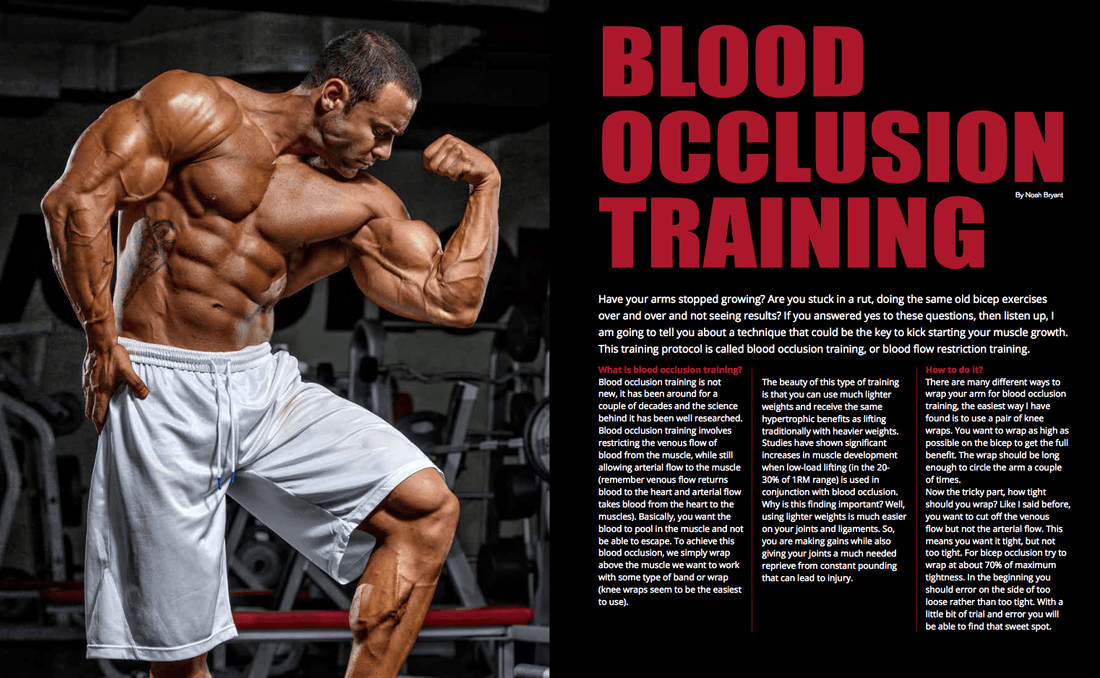

Blood Occlusion Training: Shock Arms Into New Growth
Table of Contents
Reprinted from Muscle Media
Blood Occlusion Training
By: Josh Bryant
Have your arms stopped growing? Are you stuck in a rut, doing the same old bicep exercises over and over and not seeing results? If you answered yes to these questions, then listen up, I am going to tell you about a technique that could be the key to kick starting your muscle growth. This training protocol is called blood occlusion training, or blood flow restriction training.
What is blood occlusion training?
Blood occlusion training is not new, it has been around for a couple of decades and the science behind it has been well researched. Blood occlusion training involves restricting the venous flow of blood from the muscle, while still allowing arterial flow to the muscle (remember venous flow returns blood to the heart and arterial flow takes blood from the heart to the muscles). Basically, you want the blood to pool in the muscle and not be able to escape. To achieve this blood occlusion, we simply wrap above the muscle we want to work with some type of band or wrap (knee wraps seem to be the easiest to use).
The beauty of this type of training is that you can use much lighter weights and receive the same hypertrophic benefits as lifting traditionally with heavier weights. Studies have shown significant increases in muscle development when low-load lifting (in the 20-30% of 1RM range) is used in conjunction with blood occlusion1.
Why is this finding important? Well, using lighter weights is much easier on your joints and ligaments. So, you are making gains while also giving your joints a much needed reprieve from constant pounding that can lead to injury.
 How to do it?
How to do it?
There are many different ways to wrap your arm for blood occlusion training, the easiest way I have found is to use a pair of knee wraps. You want to wrap as high as possible on the bicep to get the full benefit. The wrap should be long enough to circle the arm a couple of times.
Now the tricky part, how tight should you wrap? Like I said before, you want to cut off the venous flow but not the arterial flow. This means you want it tight, but not too tight. For bicep occlusion try to wrap at about 70% of maximum tightness. In the beginning you should error on the side of too loose rather than too tight. With a little bit of trial and error you will be able to find that sweet spot.
When to do it?
Blood occlusion training is most effective in single-joint, isolation movements. So go through your normal exercises and use the occlusion training as a finisher. You want to use a very light weight, in the 20-30% 1RM range. Really, that light. You are going to have to suck up your pride a little bit and grab the pink dumbbells at the end of the rack.
For this type of training we want the reps to be high. The first set should be in the 25-30 rep range. Because of the occlusion and the short rest periods, the subsequent sets will consist of lower reps. The last two sets should be performed until muscular failure. Aim for a total of 3-5 sets with 45 seconds rest in between each set. It is important that you do not unwrap in between sets, keep your arm wrapped up for the entire 3-5 sets!
A fair warning, this is going to hurt! It is not comfortable… but most things worthwhile are not.
Sample Bicep Workout
First you want to go through your compound and heavier movements for the day.
- Load up the EZ-Curl bar with 30% of your 1RM.
- Wrap up those arms like I described above, as high on the bicep as possible.
- Perform the first set of seated preacher curls for 30 reps.
- Rest 45 seconds.
- Perform 15-20 reps.
- Rest 45 seconds.
- Lift until muscular failure
- Rest 45 seconds.
- Lift until muscular failure.
Sample Tricep Workout
- Pick a light weight (20-30% 1RM) for tricep rope pushdowns
- Wrap up those arms as high on the bicep as possible.
- Perform the first set of tricep pushdowns for 30 reps.
- Rest 45 seconds.
- Perform 15-20 reps.
- Rest 45 seconds.
- Lift until muscular failure
- Rest 45 seconds.
- Lift until muscular failure.
If your routine is stale and your arms just don’t seem to grow, give blood occlusion training a try!
Loenneke JP, Wilson JM, Marin PJ, Zourdos MC, Bemben MG. Low intensity blood flow restriction training: A meta-analysis. Eur J Appl Physiol. 2011 Sep 16.
MUSCLE MEDIA MAGAZINE FOR MEN
The premier source of training, nutrition, supplements, fat loss and health for men.

















